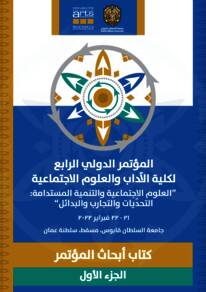Document
Enhancing resilience of UNESCO world heritage site tourist attractions : a case study of Falaj Daris.
Contributors
Publisher
College of Arts and Social Sciences, Sultan Qaboos University.
Gregorian
2022-02
Language
Arabic
English abstract
UNESCO World Heritage Sites (WHS) worldwide are vulnerable to natural and
man-made hazards. These hazards consequently affect their Outstanding
Universal Values (OUV), authenticity and integrity. Therefore, ensuring the
sustainability and resilience of these WHS against different incidents is crucial in
order to maintain the tourism flow. This study aims to identify potential risks
that might affect the Aflaj irrigation system to enhance their resilience and
highlights Falaj Daris as a case study. This study used three methods, semistructured
interviews to collect data from the Falaj Daris coordinators, local
community, and governmental specialists in managing WHS in Oman. In
addition, the use of observation and the Geographic Information System (GIS).
The use of the GIS helps to prove the outcomes of other research methods used
by highlighting the current and potential risks around Falaj Daris and its
boundaries.
The study results revealed that many threats are endangered Falaj Daris as a
result of the lack in coordination between the various parties concerned with the
management of cultural heritage in the Sultanate of Oman, especially the World
Heritage sites. This weakness in coordination led to the random planning and
multiple roles in management that has put these sites at risk. Also, Falaj Daris are
threatened by other risks such as the infringement of its boundaries and buffer
zones, urbanization, pollution, lack of tourism activities and interpretation.
Moreover, the irresponsible behaviours of some of the local people have caused
a weakness in the flow and quality of the falaj water.
82 2
The study raises several recommendations which are divided into development
aspects and management issues. They aim to enhance capacity-building,
stakeholder partnership, sustainable investment, education, experience
enhancement, tourist behaviour management, local communities engagement,
zoning, and the active use of the resources, water management, hazardous waste
management and the improvement of the legal framework.
Member of
Resource URL
Arabic abstract
مواقع التراث العالمي لليونسكو (WHS) في جميع أنحاء العالم عرضة للتأثيرات الطبيعية و
مخاطر من صنع الإنسان. وبالتالي تؤثر هذه المخاطر على مستحقاتها
القيم العالمية (OUV) والأصالة والنزاهة. لذلك ، فإن ضمان
تعد استدامة ومرونة هذه WHS ضد الحوادث المختلفة أمرًا بالغ الأهمية في
من أجل الحفاظ على تدفق السياحة. تهدف هذه الدراسة إلى تحديد المخاطر المحتملة
التي قد تؤثر على نظام الري الأفلاج لتعزيز مرونتها و
يسلط الضوء على فلج دارس كدراسة حالة. استخدمت هذه الدراسة ثلاث طرق شبه منظمة
مقابلات لجمع البيانات من منسقي فلج دارس محليين
المجتمع ، والمتخصصين الحكوميين في إدارة WHS في عمان. في
بالإضافة إلى استخدام المراقبة ونظام المعلومات الجغرافية (GIS).
يساعد استخدام نظم المعلومات الجغرافية في إثبات نتائج طرق البحث الأخرى المستخدمة
من خلال تسليط الضوء على المخاطر الحالية والمحتملة حول فلج داريس وفلاحيته
حدود.
كشفت نتائج الدراسة أن العديد من التهديدات مهددة بالانقراض على فلج دارس
نتيجة قلة التنسيق بين مختلف الجهات المعنية
إدارة التراث الثقافي في سلطنة عمان وخاصة العالم
مواقع التراث. هذا الضعف في التنسيق أدى إلى التخطيط العشوائي و
أدوار متعددة في الإدارة عرضت هذه المواقع للخطر. أيضا فلج دارس
مهددة بمخاطر أخرى مثل التعدي على حدودها وعازلة
المناطق ، والتحضر ، والتلوث ، وقلة الأنشطة السياحية والتفسير.
علاوة على ذلك ، تسببت السلوكيات غير المسؤولة لبعض السكان المحليين
ضعف في تدفق وجودة مياه الفلج.
82 2
تطرح الدراسة عدة توصيات تنقسم إلى تطوير
الجوانب وقضايا الإدارة. تهدف إلى تعزيز بناء القدرات ،
شراكة أصحاب المصلحة ، الاستثمار المستدام ، التعليم ، الخبرة
التعزيز ، إدارة السلوك السياحي ، إشراك المجتمعات المحلية ،
تقسيم المناطق والاستخدام الفعال للموارد وإدارة المياه والنفايات الخطرة
إدارة وتحسين الإطار القانوني.
مخاطر من صنع الإنسان. وبالتالي تؤثر هذه المخاطر على مستحقاتها
القيم العالمية (OUV) والأصالة والنزاهة. لذلك ، فإن ضمان
تعد استدامة ومرونة هذه WHS ضد الحوادث المختلفة أمرًا بالغ الأهمية في
من أجل الحفاظ على تدفق السياحة. تهدف هذه الدراسة إلى تحديد المخاطر المحتملة
التي قد تؤثر على نظام الري الأفلاج لتعزيز مرونتها و
يسلط الضوء على فلج دارس كدراسة حالة. استخدمت هذه الدراسة ثلاث طرق شبه منظمة
مقابلات لجمع البيانات من منسقي فلج دارس محليين
المجتمع ، والمتخصصين الحكوميين في إدارة WHS في عمان. في
بالإضافة إلى استخدام المراقبة ونظام المعلومات الجغرافية (GIS).
يساعد استخدام نظم المعلومات الجغرافية في إثبات نتائج طرق البحث الأخرى المستخدمة
من خلال تسليط الضوء على المخاطر الحالية والمحتملة حول فلج داريس وفلاحيته
حدود.
كشفت نتائج الدراسة أن العديد من التهديدات مهددة بالانقراض على فلج دارس
نتيجة قلة التنسيق بين مختلف الجهات المعنية
إدارة التراث الثقافي في سلطنة عمان وخاصة العالم
مواقع التراث. هذا الضعف في التنسيق أدى إلى التخطيط العشوائي و
أدوار متعددة في الإدارة عرضت هذه المواقع للخطر. أيضا فلج دارس
مهددة بمخاطر أخرى مثل التعدي على حدودها وعازلة
المناطق ، والتحضر ، والتلوث ، وقلة الأنشطة السياحية والتفسير.
علاوة على ذلك ، تسببت السلوكيات غير المسؤولة لبعض السكان المحليين
ضعف في تدفق وجودة مياه الفلج.
82 2
تطرح الدراسة عدة توصيات تنقسم إلى تطوير
الجوانب وقضايا الإدارة. تهدف إلى تعزيز بناء القدرات ،
شراكة أصحاب المصلحة ، الاستثمار المستدام ، التعليم ، الخبرة
التعزيز ، إدارة السلوك السياحي ، إشراك المجتمعات المحلية ،
تقسيم المناطق والاستخدام الفعال للموارد وإدارة المياه والنفايات الخطرة
إدارة وتحسين الإطار القانوني.
Category
Conferences & workshops

